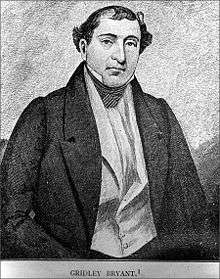Gridley Bryant
| Gridley Bryant | |
|---|---|
 | |
| Born |
1789 Scituate, Massachusetts |
| Died |
June 13, 1867 Scituate, Massachusetts |
Gridley Bryant (1789 – June 13, 1867) was an American construction engineer who ended up building the first commercial railroad in the United States and inventing most of the basic technologies involved in it. His son, Gridley James Fox Bryant, was a famous 19th-century architect and builder.
Biography
Bryant invented a portable derrick in 1823 and soon gained a reputation for being a master structure builder. He was awarded the contract to build the United States Bank in Boston, Massachusetts, and the Bunker Hill Monument in Charlestown, Massachusetts. In investigating how to move the granite needed for these projects from the quarry in Quincy to the work sites, he concluded that the best method would be via a railroad, much like that of the Liverpool and Manchester Railway which was still in the planning stages at the time. A reluctant state legislature granted Bryant a charter to build a railroad with Bunker Hill monument director Thomas Handasyd Perkins as the principal financier and owner of a majority of the shares. Construction began on the Granite Railway, one of the first railroads in North America, on April 1, 1826, with the first train operating on the railroad on October 7, 1826.
Since the railroad was essentially new technology, Bryant had to create the designs for nearly every aspect of the railroad, including the cars (4- and 8-wheel designs), track, switches, wheels, turntable, and load transfer equipment. Mr. Bryant utilized similar developments and technologies that had already been in use on the railroads in England, but he modified his design to allow for heavier, more concentrated loads and a three-foot frost line. The only real difference between Bryant's Granite Railway and the Liverpool and Manchester was in the motive power; Bryant used horses and gravity to pull his trains, while the Liverpool and Manchester used steam locomotives. Although he designed and created all of the machinery, Bryant did not file patents on any of his inventions for the railroad. In 1834, Ross Winans filed a patent for the eight-wheel car design that Bryant had first invented. Bryant was called upon as an expert witness by the Baltimore and Ohio Railroad in an effort to invalidate Winans' patent.
References
- Scholes, Robert E. (1968), The Granite Railway and its Associated Enterprises. Retrieved March 31, 2005.
- White, John H. Jr. (Spring 1986). "America's most noteworthy railroaders". Railroad History. 154: 9–15. ISSN 0090-7847. OCLC 1785797.